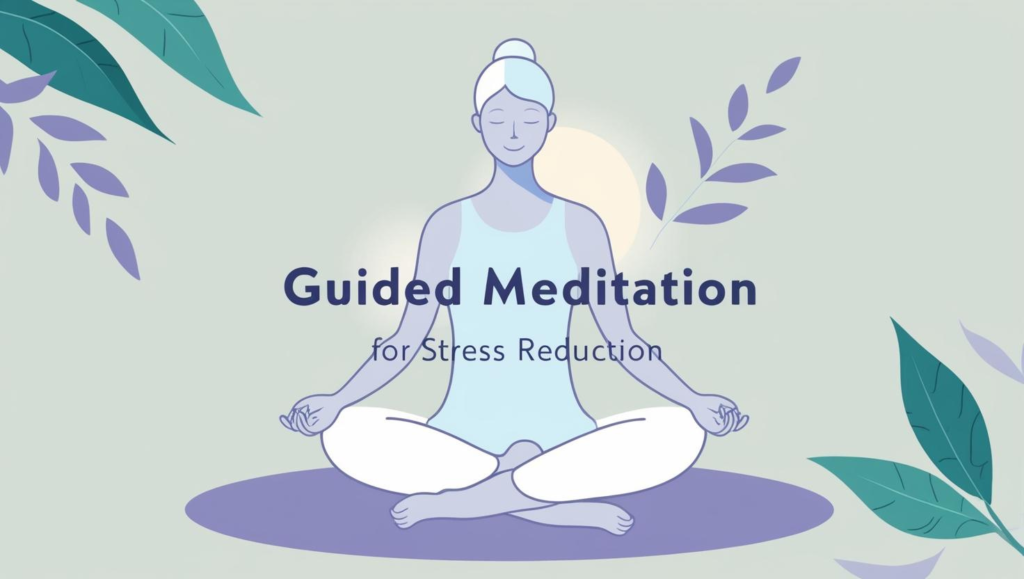Guided meditations for stress reduction have become a go-to solution for many seeking relief from the overwhelming pressures of daily life. Whether you’re juggling work deadlines, family responsibilities, or personal challenges, stress can take a toll on both your mind and body. Fortunately, guided meditations offer an accessible and effective way to find calm amidst the storm. In this article, we’ll dive into guided meditations, their benefits, how to practice them, the different types available, and tips to overcome common challenges—all focusing on using guided meditations for stress reduction.

What Are Guided Meditations?
Guided meditations are a form of meditation where a narrator—either in person, through an audio recording, or via an app—leads you through the experience. Unlike silent meditation, where you’re left to your own thoughts, guided meditations provide step-by-step instructions. These might include prompts to focus on your breath, visualize calming scenes, or relax specific parts of your body. For beginners, guided meditations for stress reduction are especially helpful because they offer structure and support, making it easier to stay engaged and relaxed.
The beauty of guided meditations lies in their simplicity. You don’t need prior experience or fancy equipment—just a quiet space, a few minutes, and a willingness to let go. This accessibility makes guided meditations for stress reduction a practical tool for anyone looking to manage stress effectively.
Why Are Guided Meditations Effective for Stress Reduction?

Stress is more than just a feeling; it’s a physiological response that can elevate cortisol levels, disrupt sleep, and even contribute to chronic health issues like high blood pressure or anxiety. Guided meditations for stress reduction work by activating the body’s relaxation response, counteracting the fight-or-flight mode that stress triggers. Research supports this: studies have shown that meditation can lower stress hormones, improve emotional health, and enhance overall well-being.
What sets guided meditations apart is their ability to keep you focused. The narrator’s voice acts as an anchor, gently pulling you back if your mind starts to wander. This makes guided meditations for stress reduction particularly effective for those who find it hard to quiet their thoughts on their own. Whether you’re new to meditation or a seasoned practitioner, this practice offers a reliable way to unwind and recharge.
Benefits of Guided Meditations for Stress Reduction
The advantages of incorporating guided meditations for stress reduction into your routine are numerous. Here’s a closer look at some of the key benefits:
- Reduced Anxiety: Guided meditations help quiet racing thoughts by guiding your focus to the present moment, easing feelings of worry and tension.
- Better Sleep: Practicing guided meditations for stress reduction before bed can calm your mind, making it easier to fall asleep and stay asleep.
- Improved Concentration: Regular meditation strengthens your ability to focus, which can boost productivity and mental clarity throughout the day.
- Physical Relaxation: Guided meditations often include techniques like deep breathing or body scans, which can lower heart rate and blood pressure, promoting physical calm.
Take Sarah, for example—a busy mom and professional who discovered guided meditations for stress reduction. She started with just 10-minute sessions each morning and noticed a significant drop in her stress levels within a week. Stories like hers illustrate how this practice can transform daily life, offering a simple yet powerful way to cope with stress.
How to Practice Guided Meditations for Stress Reduction
Ready to try guided meditations for stress reduction? Here’s a beginner-friendly guide to get started:
- Find a Quiet Space: Pick a spot where interruptions are unlikely—a cozy corner at home, a park bench, or even your office during a break.
- Set a Time Limit: Start with 5–10 minutes. As you grow more comfortable, you can extend your sessions to 20 minutes or more.
- Choose Your Guide: Options abound—apps like Calm or Headspace, free YouTube videos, or podcasts. Find a voice or style that resonates with you.
- Get Comfortable: Sit in a chair, lie down, or adopt any position that feels relaxed yet alert. The key is to avoid falling asleep unless that’s your goal!
- Follow Along: Listen to the instructions, whether they involve breathing exercises, visualizations, or body awareness. Let the guide lead the way.
Finding the right guided meditation is a personal journey. Some prefer soothing nature sounds, while others enjoy a narrator with a warm, calming tone. Experiment with different options to discover what works best for your stress reduction goals.
Types of Guided Meditations for Stress Reduction
Not all guided meditations are the same, and that’s a good thing! There are several types of guided meditations for stress reduction, each offering a unique approach to relaxation. Here are four popular ones to explore:
- Body Scan Meditation: This technique involves mentally scanning your body from head to toe, noticing and releasing tension. It’s a fantastic way to connect with your physical self and unwind.
- Visualization Meditation: Here, the guide prompts you to picture a peaceful scene—like a serene beach or a quiet forest—helping your mind escape daily stressors.
- Loving-Kindness Meditation: Known as Metta, this practice focuses on generating feelings of compassion for yourself and others, reducing negative emotions like anger or frustration.
- Breathing Exercises: Simple yet effective, these meditations guide you through deep, rhythmic breathing to soothe your nervous system and restore calm.
Each type of guided meditation for stress reduction has its strengths, so try a few to see which aligns with your needs. You might find that body scans help with physical tension, while visualization lifts your mood on tough days.
Common Challenges and How to Overcome Them
While guided meditations for stress reduction are highly effective, they’re not without hurdles, especially for beginners. Here are some common challenges and practical solutions:
- Wandering Mind: It’s normal for thoughts to drift during meditation. When this happens, don’t judge yourself—just gently refocus on the guide’s voice.
- Time Constraints: If your schedule feels packed, start small. Even 5 minutes of guided meditation for stress reduction can make a difference. Try it during a commute or lunch break.
- Doubts About Effectiveness: Skeptical? Commit to a week of daily practice and track how you feel. Many notice subtle shifts in stress levels after just a few sessions.
Patience is key. Guided meditations for stress reduction are a skill that develops over time. The more you practice, the easier it becomes to slip into a relaxed state.
Conclusion
Guided meditations for stress reduction are a powerful, accessible tool for anyone looking to reclaim peace in a hectic world. The benefits are clear: They reduce anxiety and improve sleep while enhancing focus and physical health. With a variety of techniques—like body scans, visualisations, and breathing exercises—you can tailor this practice to suit your needs. Simple adjustments can keep you on track even if you face challenges like a wandering mind or a busy schedule.
Why not start today? Set aside a few minutes for guided meditations for stress reduction and take the first step toward a calmer, more balanced life. Whether you’re a beginner or a meditation pro, this practice offers a reliable way to manage stress and nurture your well-being.



Pingback: The Benefits of Mindfulness Meditation for Stress Reduction: A Path to Inner Peace - mysproutapp.com